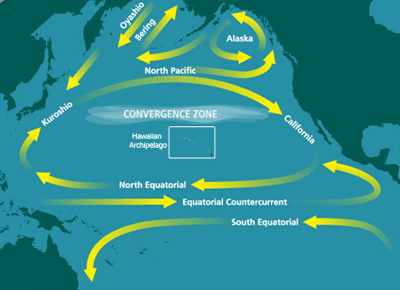The operator of the stricken Fukushima
nuclear plant has been dumping something like a
thousand tons per day of radioactive water into the
Pacific ocean.
The whole complex is
leaking like a sieve, and the rivers of water pumped into the
reactors every day are just
pouring into the ocean (with only a slight delay).
Most people assume that the ocean will
dilute the radiation from Fukushima enough that any radiation reaching the West
Coast of the U.S. will be low.
For example, the Congressional Research
Service
wrote in April:
Scientists have stated that radiation in the ocean very quickly
becomes diluted and would not be a problem beyond the coast of Japan.
***
U.S. fisheries are unlikely to be affected because radioactive
material that enters the marine environment would be greatly diluted before
reaching U.S. fishing grounds.
And a Woods Hole oceanographer
said:
“The Kuroshio current is considered like the Gulf Stream of the
Pacific, a very large current that can rapidly carry the radioactivity into the
interior” of the ocean, Buesseler said.
“But it also dilutes along the way, causing a lot of mixing and
decreasing radioactivity as it moves offshore.”
But – just as we noted
2
days after the earthquake hit that the jet stream might
carry
radiation to the U.S. by wind – we are now warning that ocean currents might
carry more radiation to the at least some portions of the West Coast of North
America than is assumed.
Specifically, we
noted
more than a year ago:
The ocean currents head from Japan to the West Coast of the
U.S.
The floating debris will likely be carried by currents off of
Japan toward Washington, Oregon and California before turning toward Hawaii and
back again toward Asia, circulating in what is known as the North Pacific gyre,
said Curt Ebbesmeyer, a Seattle oceanographer who has spent decades tracking
flotsam.
***
“All this debris will find a way to reach the West coast or
stop in the Great Pacific Garbage Patch,” a swirling mass of concentrated marine
litter in the Pacific Ocean, said Luca Centurioni, a researcher at Scripps
Institution of Oceanography, UC San Diego.

CNN said that “the Hawaiian islands may get a new and
unwelcome addition in coming months — a giant new island of debris floating in
from Japan.” It relied in part on work done by the University of Hawaii’s
International Pacific Research Center,
which predicts that:
“In three years, the [debris] plume will reach the U.S. West
Coast, dumping debris on Californian beaches and the beaches of British
Columbia, Alaska, and Baja California. The debris will then drift into the
famous North Pacific Garbage Patch, where it will wander around and break into
smaller and smaller pieces. In five years, Hawaii shores can expect to see
another barrage of debris that is stronger and longer lastingthan the first one.
Much of the debris leaving the North Pacific Garbage Patch ends up on Hawaii’s
reefs and beaches.”
The debris mass, which appears as an island from the air,
contains cars, trucks, tractors, boats and entire houses floating in the current
heading toward the U.S. and Canada, according to ABC News.
The bulk of the debris will likely not be radioactive, as it
was presumably washed out to sea during the initial tsunami – before much
radioactivity had leaked. But this shows the power of the currents from Japan to
the West Coast.
An animated graphic from the University of
Hawaii’s
International Pacific
Research Center shows the projected dispersion of debris from Japan:
Indeed, an
island
of Japanese debris the size of California is hitting the West Coast of North
America … and some of it
is
radioactive.
In addition to radioactive debris, MIT says
that
seawater which is itself radioactive may begin hitting
the West Coast within 5 years. Given that the debris is hitting faster than
predicted, it is possible that the radioactive seawater will as well.
And the Congressional Research Service
admitted:
However, there remains the slight potential for a
relatively narrow corridor of highly contaminated water leading away
from Japan …
***
Transport by ocean currents is much slower, and additional
radiation from this source might eventually also be detected in North Pacific
waters under U.S. jurisdiction, even months after its release. Regardless of
slow ocean transport, the long half-life of radioactive cesium isotopes means
that radioactive contaminants could remain a valid concern
for
ears.
Indeed, nuclear expert Robert Alvarez –
senior policy adviser to the Energy Department’s secretary and deputy assistant
secretary for national security and the environment from 1993 to 1999 –
wrote yesterday:
According to a previously secret 1955 memo from the U.S. Atomic
Energy Commission regarding concerns of the British government over contaminated
tuna,
“dissipation of radioactive fall-out in ocean waters is not a
gradual spreading out of the activity from the region with the highest
concentration to uncontaminated regions, but that in all probability
the process results in scattered
pockets and streams of higher
radioactive materials in the Pacific. We can speculate that tuna which
now show radioactivity from ingested materials [this is in 1955,
not
today] have been living, in or have passed through, such pockets; or have
been feeding on plant and animal life which has been exposed in those
areas.”
Because of the huge amounts of radioactive
water Tepco is dumping into the Pacific Ocean, and the fact that the current
pushes waters from Japan to the West Coast of North America, at least some of
these radioactive “streams” or “hot spots” will likely end up impacting the West
Coast.



No comments:
Post a Comment